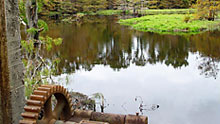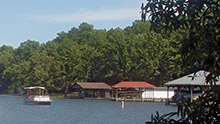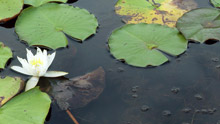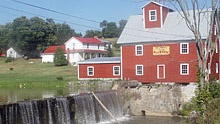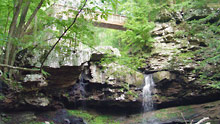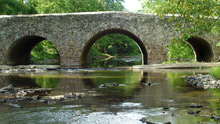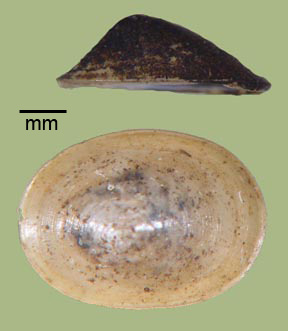> Habitat & Distribution
This limpet is widespread on rocks and woody debris in gently-flowing or cooler waters throughout North America east of the Great Plains, from Florida to southern Ontario and Quebec (Basch 1963, Clarke 1981, Walther et al. 2006). Laevapex populations are more common in larger and mid-sized rivers with calmer waters, and are not typically found in smaller and rockier streams. FWGNA incidence rank I-5.
> Ecology & Life History
McMahon (1975) reported simple annual life cycles (type A) for two L. fuscus populations in New York, and two generations per year (Bii) in a third. The bioenergetic data collected by McMahon suggest that reproductive effort in this species is in line with expectation from adult weight, and hence that their life history strategy is Undifferentiated (Dillon 2000: 126 - 135). Jokinen s (1985) Connecticut population of L. fuscus also displayed a type-A cycle.
Jokinen's (1987) analysis of the distribution of L. fuscus in Connecticut and New York led her to classify it as a High-S species, found only in the most species-rich communities. Dillon s (2000: 360-363) reanalysis of these data confirmed the Undifferentiated life history adaptation suggested by the earlier stufy of McMahon.
> Taxonomy & Systematics
Adams (1841) originally described fuscus in the genus Ancylus, which was grouped into the subgenus Laevapex by Walker (1903) and raised to the full genus level by Basch (1959a, b, c).
The shells of Laevapex vary in outline from elliptical to nearly circular. Those in the latter category have sometime been assigned to the nomen L. diaphanus (Haldeman 1841). Much of this morphological variation is certainly ecophenotypic, however (McMahon 2004). The recent research of A. Walther and her colleagues (2006) confirms that L. diaphanus is not genetically distinct from L. fuscus, nor are the more recent nomina peninsulae (Pilsbry & Johnson 1903) or arkansasesis (Walker 1917). See my essay of 20July07 from the link below.
> Maps and Supplementary Resources
- Laevapex distribution in drainages of The Ohio (2019)
- Ancyid distribution in Atlantic drainages (2023)
- Laevapex distribution in the Tennessee/Cumberland (2022)
- Ancylid distribution in Georgia and the Florida panhandle (2025)
> Essays
- See my 20July07 post to the FWGNA group for a review of the 2006 paper by Walther and colleagues, "Phylogenetic Sporting and the Genus Laevapex."
- See my post of 26Sept14 for good, comparative figures illustrating "The egg masses of freshwater pulmonate snails."
- See my essay of 11Jan17 for an interesting photo of Laevapex on the back of a Belostomatid bug - "A previously unrecognized symbiosis?"
> References
Basch, P. (1959a) the anatomy of Laevapex fuscus, a fresh-water limpet (Gastropoda: Pulmonata). Misc. Publ. Mus. Zool. Univ. Michigan 108: 1 - 56.
Basch, P. (1959b) Studies on the development and reproduction of the fresh-water limpet Ferrissia shimekii (Pilsbry). Trans. Amer. Micros. Soc. 78: 269 - 276.
Basch, P. (1959c) Status of the genus Gundlachia (Pulmonata: Ancylidae). Occ. Pprs. Mus. Zool. Univ. Michigan 602: 1 - 9.
Basch, P. (1963) A review of the recent freshwater limpet snails of North America. Bull. Mus. Comp. Zool. Harvard, 129, 399-461.
Clarke, A. H. (1981) The Freshwater Molluscs of Canada. National Museums of Canada, Ottawa. 445 pp.
Dillon, R. T., Jr. (2000) The Ecology of Freshwater Molluscs. Cambridge University Press, United Kingdom. 509 pp.
Hubendick, B. (1964) Studies on Ancylidae, The subgroups. Meddelanden Fran Goteborgs Musei Zoologiska Avendelining, 137. (Goteborgs Kungl. Vetenskaps-Och Vitterhets-Samhalles Handlingar. Sjatte Foljden. Ser. B.) 9, 1-72.
Jokinen, E. (1985) Comparative life history patterns within a littoral zone snail community. Verh. Internat. Verein, Limnol., 22: 3292-3399.
Jokinen, E. (1987) Structure of freshwater snail communities: Species-area relationships and incidence categories. Amer. Malac. Bull. 5: 9 - 19.
McMahon, R.F. (1973) Respiratory variation and acclimation in the freshwater limpet, Laevapex fuscus. Biol. Bull. 145: 492-508.
McMahon, R. F. (1975) Growth, reproduction and bioenergetic variation in three natural populations of a freshwater limpet Laevapex fuscus (Adams). Proc. Malac. Soc. Lond., 41: 331-351.
McMahon, R. F. (1976) Growth, reproduction and life cycle in six Texan populations of two species of fresh-water limpets. Am. Midl. Nat. 95: 174-185.
McMahon, R. F. (2004) A 15-year study of interannual shell shape variation in a population of freshwater limpets (Pulmonata: Basommatophora: Ancylidae). Am. Malac. Bull. 19: 101-109.
Russell-Hunter, W. D. & R. F. McMahon (1976) Evidence for functional protandry in a freshwater limpet, Laevapex fuscus. Trans. Amer. Micros. Soc. 95: 174 - 182.
Walther, A. C., T. Lee, J. B. Burch, & D. O'Foighil (2006) E Pluribus Unum: A phylogenetic and phylogeographic reassessment of Laevapex (Pulmonata: Ancylidae), a North American genus of freshwater limpets. Molec. Phyl. Evol. 40: 501 - 516. 6.
Walker, B. (1903) Notes on eastern American ancyli. Nautilus 17: 13 - 19, 25 - 31.

